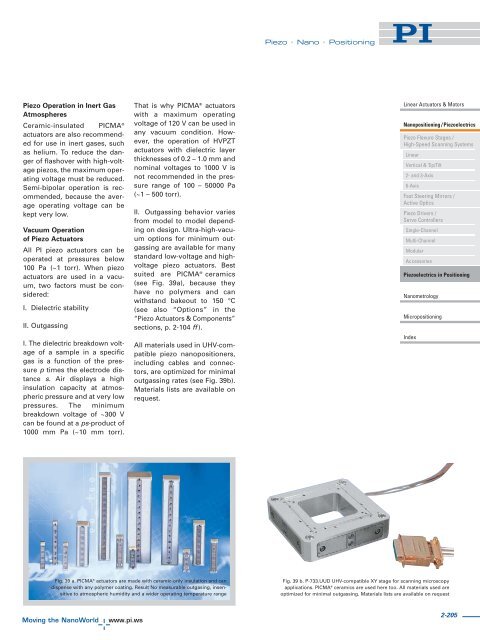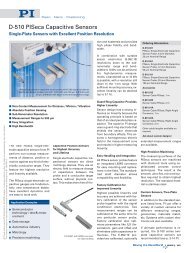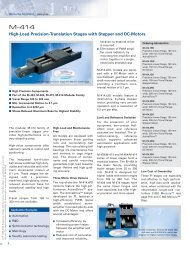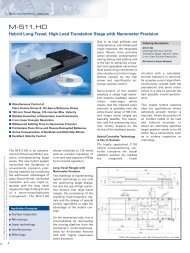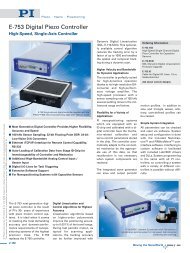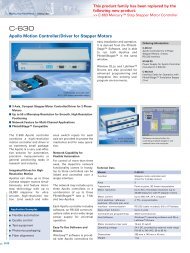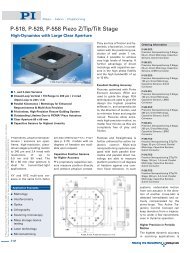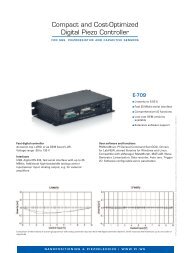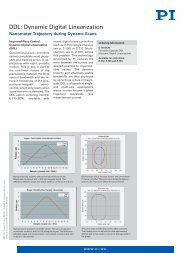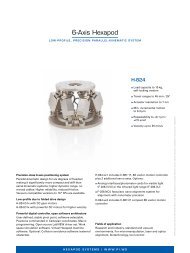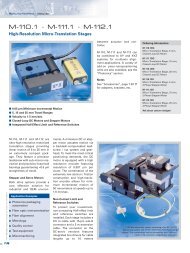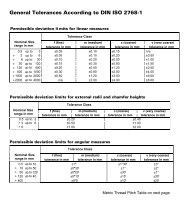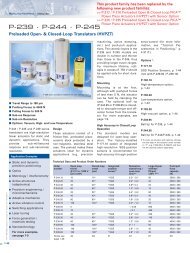Piezoelectrics in Positioning - PZT & Piezo Actuators: Sub ...
Piezoelectrics in Positioning - PZT & Piezo Actuators: Sub ...
Piezoelectrics in Positioning - PZT & Piezo Actuators: Sub ...
Create successful ePaper yourself
Turn your PDF publications into a flip-book with our unique Google optimized e-Paper software.
<strong>Piezo</strong> • Nano • Position<strong>in</strong>g<strong>Piezo</strong> Operation <strong>in</strong> Inert GasAtmospheresCeramic-<strong>in</strong>sulated PICMA ®actuators are also recommendedfor use <strong>in</strong> <strong>in</strong>ert gases, suchas helium. To reduce the dangerof flashover with high-voltagepiezos, the maximum operat<strong>in</strong>gvoltage must be reduced.Semi-bipolar operation is recommended,because the averageoperat<strong>in</strong>g voltage can bekept very low.Vacuum Operationof <strong>Piezo</strong> <strong>Actuators</strong>All PI piezo actuators can beoperated at pressures below100 Pa (~1 torr). When piezoactuators are used <strong>in</strong> a vacuum,two factors must be considered:I. Dielectric stabilityII. Outgass<strong>in</strong>gI. The dielectric breakdown voltageof a sample <strong>in</strong> a specificgas is a function of the pressurep times the electrode distances. Air displays a high<strong>in</strong>sulation capacity at atmosphericpressure and at very lowpressures. The m<strong>in</strong>imumbreakdown voltage of ~300 Vcan be found at a ps-product of1000 mm Pa (~10 mm torr).That is why PICMA ® actuatorswith a maximum operat<strong>in</strong>gvoltage of 120 V can be used <strong>in</strong>any vacuum condition. However,the operation of HV<strong>PZT</strong>actuators with dielectric layerthicknesses of 0.2 – 1.0 mm andnom<strong>in</strong>al voltages to 1000 V isnot recommended <strong>in</strong> the pressurerange of 100 – 50000 Pa(~1 – 500 torr).II. Outgass<strong>in</strong>g behavior variesfrom model to model depend<strong>in</strong>gon design. Ultra-high-vacuumoptions for m<strong>in</strong>imum outgass<strong>in</strong>gare available for manystandard low-voltage and highvoltagepiezo actuators. Bestsuited are PICMA ® ceramics(see Fig. 39a), because theyhave no polymers and canwithstand bakeout to 150 °C(see also “Options” <strong>in</strong> the“<strong>Piezo</strong> <strong>Actuators</strong> & Components”sections, p. 2-104 ff ).All materials used <strong>in</strong> UHV-compatiblepiezo nanopositioners,<strong>in</strong>clud<strong>in</strong>g cables and connectors,are optimized for m<strong>in</strong>imaloutgass<strong>in</strong>g rates (see Fig. 39b).Materials lists are available onrequest.L<strong>in</strong>ear <strong>Actuators</strong> & MotorsNanoposition<strong>in</strong>g / <strong><strong>Piezo</strong>electrics</strong><strong>Piezo</strong> Flexure Stages /High-Speed Scann<strong>in</strong>g SystemsL<strong>in</strong>earVertical & Tip/Tilt2- and 3-Axis6-AxisFast Steer<strong>in</strong>g Mirrors /Active Optics<strong>Piezo</strong> Drivers /Servo ControllersS<strong>in</strong>gle-ChannelMulti-ChannelModularAccessories<strong><strong>Piezo</strong>electrics</strong> <strong>in</strong> Position<strong>in</strong>gNanometrologyMicroposition<strong>in</strong>gIndexFig. 39 a. PICMA ® actuators are made with ceramic-only <strong>in</strong>sulation and candispense with any polymer coat<strong>in</strong>g. Result No measurable outgas<strong>in</strong>g, <strong>in</strong>sensitiveto atmospheric humidity and a wider operat<strong>in</strong>g temperature rangeFig. 39 b. P-733.UUD UHV-compatible XY stage for scann<strong>in</strong>g microscopyapplications. PICMA ® ceramics are used here too. All materials used areoptimized for m<strong>in</strong>imal outgass<strong>in</strong>g. Materials lists are available on request2-205


